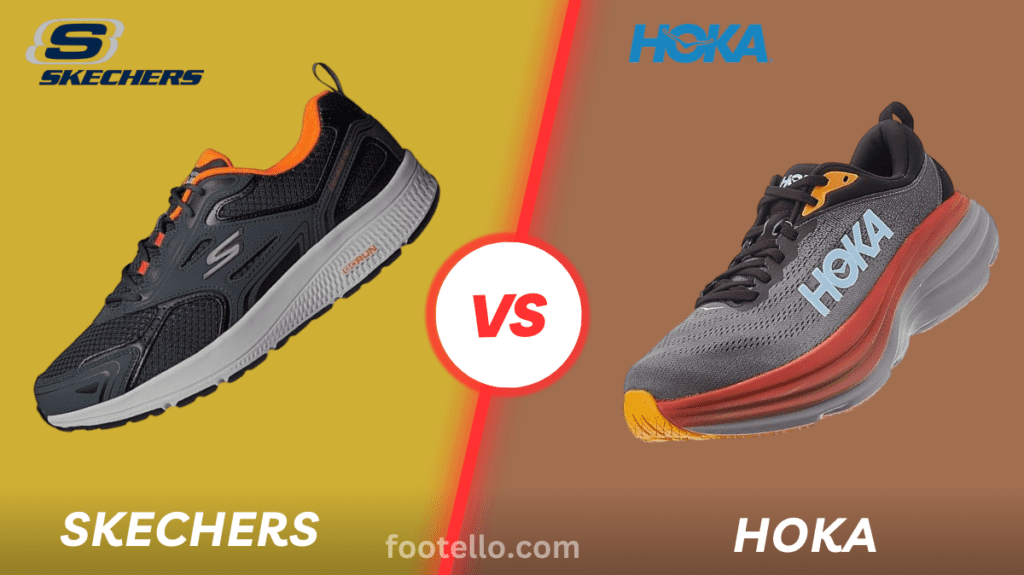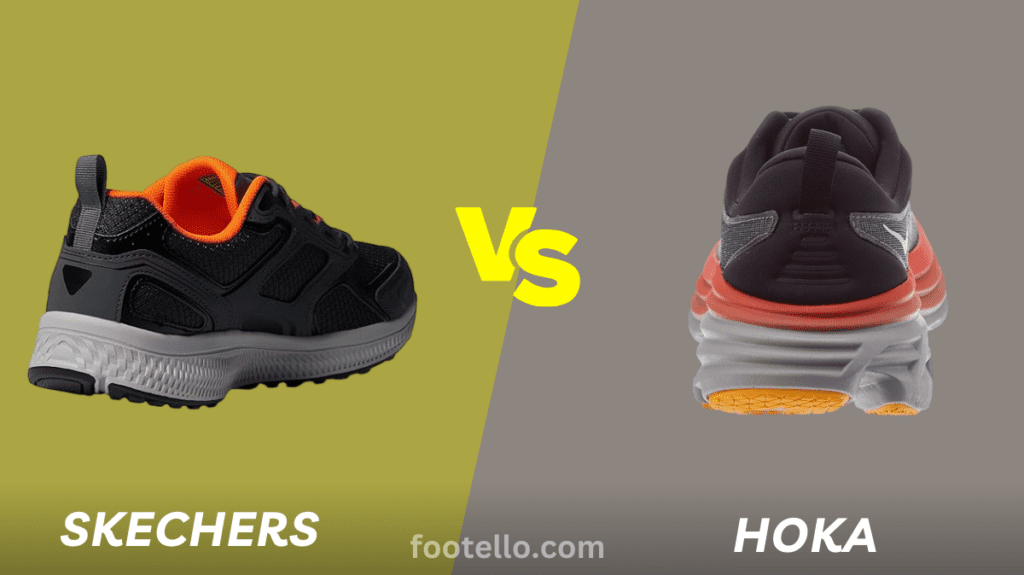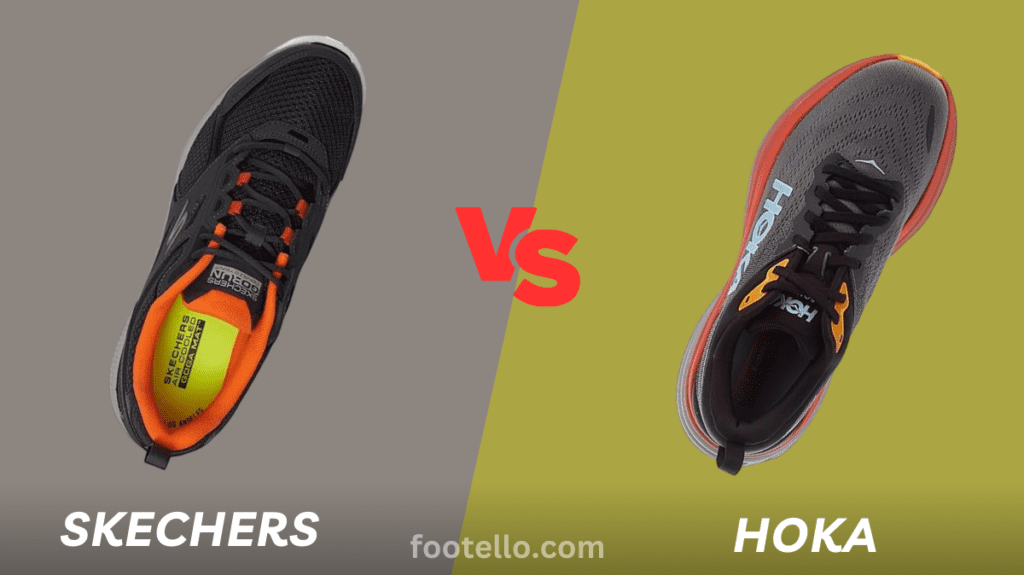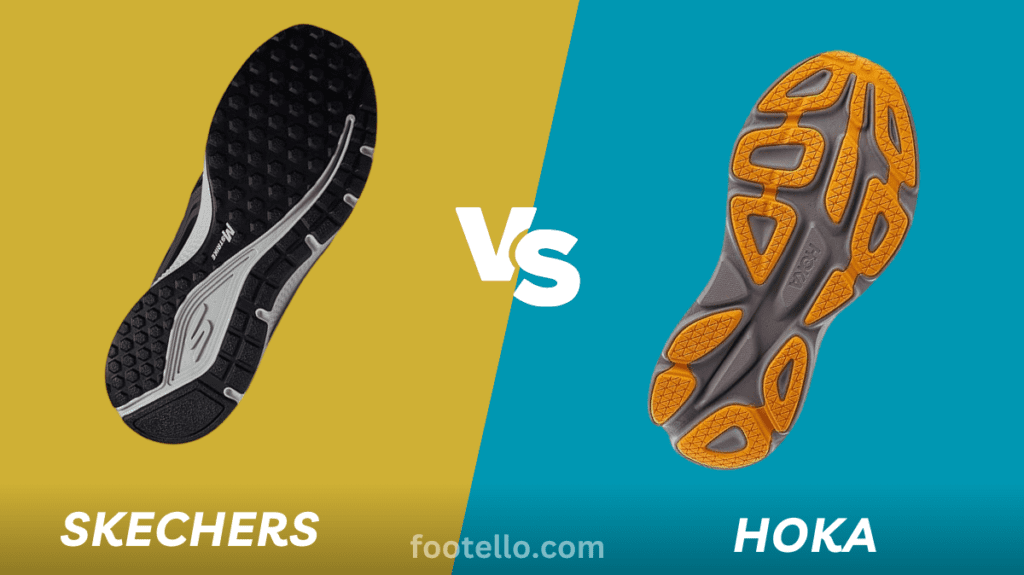Skechers and Hoka both offer popular athletic shoe options catering to runners and gymgoers alike.
But with different technologies, designs, and pricing, which brand should you go with?
We will compare Skechers GO Run vs Hoka sneaker models side-by-side across factors like cushioning, fit and sizing, intended use, style variety, and value.

Keep reading to determine the ideal match based on your individual preferences and needs.
Difference Between Skechers GO Run vs Hoka
The primary contrast between Skechers GO Run and Hoka shoes is their midsole technology: Skechers GO Run utilizes lightweight responsive foam, while Hoka is renowned for its maximally cushioned midsoles featuring a deeply rockers geometry designed to provide an ultra-smooth, high-cushioned ride.
Before comparing the specifics, here is an overview of Skechers GO Run vs Hoka:
| Factor | Skechers GO Run | Hoka |
| Cushioning Amount | Moderate cushioning | Maximal, ultra-soft cushioning |
| Heel to Toe Drop | 8-10mm drop | 4-5mm drop |
| Fit | Runs small, size up 0.5-1 | Runs large, size down 0.5-1 |
| Toe Box | The tapered, narrow-toe box | The wide, foot-shaped toe box |
| Intended Use | Short to mid-distance training | Recovery runs and long distances |
| Pace | Uptempo faster paces | Slow recovery paces |
| Surfaces | Roads, light trails | Hard surfaces like roads |
| Pronation Support | Best for neutral | Also supports under-pronation |
| Weight | Lightweight (8.5-10.5 oz) | Heavier (9-12 oz) |
| Price Range | $50-$160 | $100-$170 |
| Overall Value | Excellent value for technologies | High price doesn’t always match quality |
The key differences come down to the amount of cushioning, sizing/fit, ideal use cases, weight, and value provided between these two popular athletic sneaker brands.
Skechers strikes more of a balance while Hoka goes all-in on maximum cushioning above all else.

Pros and Cons
Pros: Skechers GO Run
- Relatively affordable price point
- Lightweight and flexible for a natural running feel
- Responsive midsole cushioning provides good energy return
- Durable rubber outsole with reliable traction
Cons: Skechers GO Run
- May not offer as much high-impact protection as max-cushioned shoes
- Midsole cushioning may break down faster than premium brands
- Limited color/style options compared to some competitors
Pros: Hoka Running
- Maximalist cushioning provides superior impact protection
- Rocker-shaped midsole promotes a smooth, efficient stride
- Wide, stable platform helps prevent rolling of the feet
- Variety of models for different running styles and surfaces
Cons: Hoka Running
- Significantly more expensive than many other running shoe brands
- Extremely thick, chunky profile can take some getting used to
- May feel less responsive and connected to the ground for some runners
Which Shoes Are Good for Different Activities
Shoes for Running
- Skechers GO Run: Skechers’ GO Run line is designed for neutral runners who want a responsive, lightweight shoe. Models like the GO Run Ride feature responsive cushioning and a flexible design that supports a natural running gait.
- Hoka: Hoka shoes are known for their thick, high-stack midsoles that provide maximum cushioning and support. Hoka running shoes like the Clifton and Bondi offer a very plush, protective ride, though they may feel less responsive than some traditional trainers.
Shoes for Walking
- Skechers GO Run: The flexible, cushioned midsoles in Skechers GO Run shoes make them a comfortable choice for walking. The lightweight design also reduces fatigue over longer distances.
- Hoka: Hoka’s ample cushioning and rocker-like sole geometry provide excellent shock absorption and comfort for walking. The supportive, stable ride of Hoka shoes can be beneficial for those who need extra underfoot protection.
Shoes for Standing All Day
- Skechers GO Run: The cushioning and support in Skechers GO Run models can help reduce foot fatigue when standing for long periods. The lightweight, flexible build also promotes all-day comfort.
- Hoka: Hoka’s max-cushioned midsoles excel at providing high-level comfort and support for all-day wear. The stability and plush feel of Hoka shoes make them a great option for those who need extra support when standing.
Now that you have an overview of the Skechers GO Run vs Hoka differences, read on for an in-depth feature-by-feature comparison.
Cushioning and Stability Comparison
A main point of differentiation is cushioning and stability:
| Cushioning & Stability | Skechers GO Run | Hoka |
| Cushioning Amount | Moderate cushioning | Maximum cushioning |
| Cushioning Feel | Responsive, supportive | Ultra-soft, thick |
| Stability | Stable neutral platform | Less stable structure |
| Heel Drop | 8-10mm drop preferred | 4-5mm heel drop |
- Skechers GO Run utilizes a moderate midsole cushioning level to balance softness and response. The platform remains stable for most neutral runners using an 8-10mm heel drop.
- Hoka packs in the maximum cushion possible with a pillow-soft feel unmatched in the industry. But the soft layers can feel less stable at faster paces. Hokas use a lower 4-5mm heel drop preferred by some.
So Skechers offers versatile padding for various runners while Hoka prioritizes cloud-like comfort above all else.
Intended Uses Comparison
Therefore, the shoes work ideally for:
| Best Uses | Skechers GO Run | Hoka |
| Preferred Runs | Short to mid-distance training | Recovery days and long distances |
| Surfaces | Roads, light trails | Hard surfaces like roads |
| Foot Types | Neutral pronation | Underpronation support needed |
| Speeds | Uptempo faster paces | Slower recovery paces |
- Skechers GO Run supports steady uptempo miles across roads and groomed trails for those with neutral pronation patterns preferring some midsole response.
- Hoka excels at ultra-distance road runs given the enhanced shock absorption, despite less stability at faster speeds. Best for neutral to underpronating foot types.
So Skechers work well for varied training while Hoka solves long-run cushion and comfort needs if willing to compromise some speed.

Fit and Sizing Comparison
Skechers and Hoka shoes also show marked fit and length differences that impact sizing:
| Fit & Length | Skechers GO Run | Hoka |
| Overall Fit | Runs small, order 0.5-1 size up | Runs large, size down 0.5-1 |
| Toe Box | Tapered, snug toe box | Altra-like wide-toe box |
| Other Widths | Some wide sizes are available | No – maximalist cushion limits |
| Common Complaint | Too narrow through midfoot | Too short due to sizing down |
- Skechers run nearly a full-size small with narrow builds, making sizing up necessary for most. Wide sizes help but can still feel too tight midfoot for some.
- Hoka shoes fit very long due to the thick cushion layers. This forces most into sizing down by 0.5-1 full sizes, leading to potential toe jamming for length. The extra wide-toe box balances this out.
So trying both brands on based on your usual size is critical to determine an ideal personal fit.
Weight Comparison
With more cushion comes more weight usually:
| Shoe Weight | Skechers GO Run | Hoka |
| Heavier or Lighter | Skechers run lighter | Hoka runs heavier |
| Exact Weight | 8.5 oz – 10.5 oz typical | 9 oz – 12 oz typical |
- Skechers keep weights modest around 8-11 ounces depending on if designed for speed or training/distance.
- Hoka’s maximize cushion approach leads most models into the 10-12 ounce range or slightly above. More weight but also more underfoot comfort.
So Skechers suit those wanting lighter, faster trainers while Hoka supports ultra-distance needs over speed.

Style Variety Comparison
For styling options:
| Style Choices | Skechers GO Run | Hoka |
| Lifestyle Models | ✅ Wide range of knit and mesh sneaker styles | ❌ Limited lifestyle options currently |
| Performance Models | ✅ Training to racing models available | ✅ Numerous performance styles like Bondi, Rincon, etc. |
| Colors | ✅ Many colors across models | ❌ Mostly neutral colors |
- Skechers offers greater versatility with dozens of casual GO Run styles using knit/mesh in varied color schemes alongside performance options.
- Hoka has grown its lifestyle lineup but still focuses mainly on core neutral-colored performance runners built around its cushioning legacy.
So Skechers provides both lifestyle and athletic variety whereas Hokas currently stays true to just performance running.
Value and Cost Comparison
Budget-conscious shoppers also benefit from Skechers pricing:
| Cost & Value | Skechers GO Run | Hoka |
| Price Range | $50 – $160 | $100 – $170 |
| Value Rating | 🔥🔥🔥🔥 | 🔥🔥🔥 |
| Reasonable Quality? | ✅ Great value for cost | ❌ Prices don’t always match quality |
- Skechers positions models mostly from a very fair $60-$120 depending on technology levels offered, representing a great value equation.
- Hoka retail prices run from $100 up above $150+ on key models. Some consumers feel this stretches the budget for what the shoes deliver.
So Skechers does well-maximizing value across price points while Hoka charges a premium that’s harder to match expectations for.

Customer Ratings
| Product | Rating | User Review |
|---|---|---|
| Skechers GO Run | ⭐⭐⭐⭐⭐ | “Best running shoes ever! They provide excellent cushioning and support without feeling heavy or bulky. Highly recommended for long runs or everyday wear.” |
| Hoka | ⭐⭐⭐⭐⭐ | “Game changer for my knees and joints! The thick cushioned soles make running feel effortless and pain-free. Worth every penny for the comfort and durability.” |
And here is a price comparison in table format on “Skechers GO Run vs Hoka”:
| Product | Price Range |
| Skechers GO Run | $60 – $120 |
| Hoka | $115 – $160 |
Please note that prices may vary depending on the specific model and retailer. The Skechers GO Run line tends to be more affordable, while Hoka shoes generally come at a premium price point due to their advanced cushioning technology.
Conclusion
To wrap up, Skechers and Hoka offer comparable athletic shoe styles but diverge when it comes to balancing cushion needs with versatility.
Skechers GO Run line is a dependable middle ground delivering responsive padding and support for various running paces and distances.
The sizes may run short but represent an outstanding value overall against competing brands.
Hoka one one pioneered the maximalist super-soft cushion category and excels at keeping long runs feeling comfortable.
But the narrow, sizing down fit along with stability tradeoffs limits applicability for more agile training. Hokas also sell at premium prices.
So choose Skechers if you want customizable, responsive comfort you can wear affordably both on roads and lifestyle occasions.
Pick Hoka when you crave the maximum underfoot plush without compromise.
Either way, enjoy bouncing back stronger with some extra pep in your step mile after mile!
Frequently Asked Questions
Do Skechers or Hoka have more arch support?
Most Hoka shoes will offer more contouring and arch cradle support thanks to using ortho-lite foam and compression midsoles. Skechers instead utilize neutral cushion foams so those with high arches may require added insoles.
Are Skechers or Hoka better for walking?
Skechers tend to excel more at both walking and running versatility. Many Hoka models feature exaggerated heel drops and rigid midsoles ideal for forward run momentum versus allowing natural foot flex needed for walking. So Skechers can make better all-day lifestyle trainers.
Do Skechers GO Run shoes have removable insoles?
Some Skechers performance models feature 5GEN insoles that can be removed and replaced to customize the fit. But many GO Run lifestyle models have non-removable insoles so check each specific shoe’s details before purchasing.
Where are Skechers/Hoka shoes made?
Both Skechers and Hoka manufacture their athletic sneakers primarily in factories throughout China, Vietnam, and Indonesia for production economies of scale. Quality and processes meet global industry standards.
Share your love